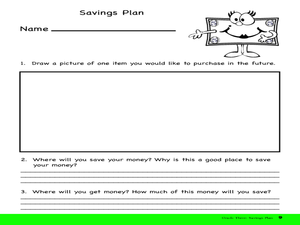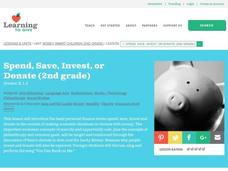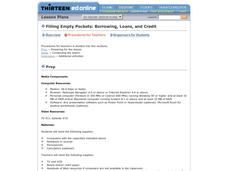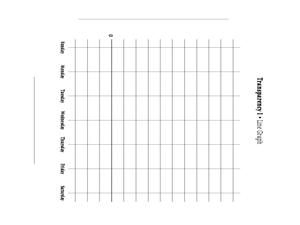Curated OER
Saturday Sancocho
Students barter with each other in order to get ingredients to make chicken sancocho. In this trading lesson plan, students read a story about a family in Central or South America who have to barter to get their needs. Then students try...
Curated OER
U.S. Penny to Get Four New Designs
Students look at U.S. currency and read about plans to change the back of U.S. pennies. In this current events instructional activity, the teacher introduces a news article with a discussion of money and a vocabulary activity, then...
Curated OER
Real-World Reasonableness
Fifth graders apply math to real-world situations. In this mathematics lesson plan, 5th graders are read the book, "Math Curse," which discusses ways in which math is used each day. Students then write a sequel to the book in groups,...
Curated OER
Labor, Choice, and Sales Tax
Students consider the idea of earning and spending money. For this money management lesson plan, students discuss the concept of saving and spending money through the reading of a story and by completing several activities that involve...
Curated OER
The Price Is Right - TV Game Show
Students play variation of TV game show "The Price is Right" to identify coins and their values.
Curated OER
How do You Stack Up? Revisited
Students estimate the thickness of coins. In this stack up instructional activity, students stack pennies, nickels, dimes and quarters. They calculate and record the thickness of each coin. Students stack coins and estimate the height...
Curated OER
Having a Savings Plan
Students discover the importance of saving and spending. In this finance instructional activity, students read the book Kermit the Hermit and discuss the differences between needs and wants. The students complete worksheets concerning...
Curated OER
The Great Cookie Company
Fourth graders implement real life application of money, problem solving, economics, and consumer awareness. In this three week economics unit, 4th graders operate a business, write checks, balance accounts, and market their product.
Curated OER
Money Smart children
Students elementary financial vocabulary words: spend, save, invest and donate. In this finance lesson plan, students respond to the story "Sam and the Lucky Moon." Students describe the concepts of wants and needs, resources, scarcity,...
Curated OER
Going Shopping
Students investigate the value of money. In this money instructional activity, students simulate going shopping in their classrooms for various objects. Students use play money to pay for the objects.
Curated OER
It's On Sale
First graders read the book The Great Pet Sale to learn about economics and advertisements. For this economics lesson plan, 1st graders read the book The Great Pet Sale and define related vocabulary words. Students compare prices to find...
Curated OER
The Hundred Penny Box
Students compare how people save money in financial institutions, after reading the story, The Hundred Penny Box. They analyze the advantages of regular saving and how savings grow with compounding.
Curated OER
Combien co¿¿te?
Students engage in conversation using the target vocabulary and grammar structure while discussing prices in euro. They also engage in listening and writing skills related to these topics. Finally, students identify and analyze the...
Curated OER
FILLING EMPTY POCKETS: BORROWING, LOANS AND CREDIT.
Students learn that maintaining financial security takes a good math understanding. In this lesson, students apply mathematical formulas to make important financial decisions like getting the right loan to buy a house, decide which...
Curated OER
Less Than Zero
Students keep track of money. In this money management lesson, students read Less Than Zero by Stuart J. Murphy and manipulate a number line to keep track of spending and borrowing in the story.
Curated OER
From the Mixed Up Files of Mrs. Basil E. Frankweiler
Students listen to From the Mixed-up Files of Mrs. Basil F. Frankweiler and discuss wants and needs. For this iincome and expenses lesson, students relate the adventures of the children in the book to a real life financial situation....
Curated OER
Show Me the Money
Pupils investigate financial applications of mathematics in this mathematics lesson. They will investigate equations that represent a company’s income, expense, and profit functions and use those equations to identify break even points...
Curated OER
Literacy Activity: Mouse Shapes
Young scholars listen to the book Mouse Shapes and identify the shapes in the book as it is being read. In this shapes lesson, students identify the shapes in the book, and then play with cut out shapes that they can hold in their hands.
Curated OER
Math TODAY - The New Color of Money
High schoolers work with large numbers when determining the height of a stack of $20 bills.
Federal Reserve Bank
Financial Goals
Do you have financial goals? How will you make them happen? Help your pupils answer these questions through this interactive project. They create goals and a plan for reaching them as one of many high school algebra projects.
Federal Reserve Bank
Income Taxes
Most adults dread April 15 — tax day! Tax preparation can be intimidating even for adults. Build confidence by leading individuals through the process and then give them a scenario to practice. The exercise uses tax vocabulary to give...
Teach Engineering
Processes on Complex Networks
Introduces your class to random processes in networks with an activity that uses information about disease spread using the susceptible, infectious, resistant (SIR) model. Participants determine whether a susceptible person becomes...
Curated OER
School Fair Cakewalk
Students identify and research various suitable school carnival activities. Then they work together to plan, design, and run all aspects of a school carnival. Students also add up their costs for the event and the amount of money it...
Illustrative Mathematics
Buying Protein Bars and Magazines
Packing for a trip? This activity allows learners to decide how many magazines and protein bars they can buy with twenty dollars. They can organize their work in a chart to track how many items they can purchase. There are two different...

























